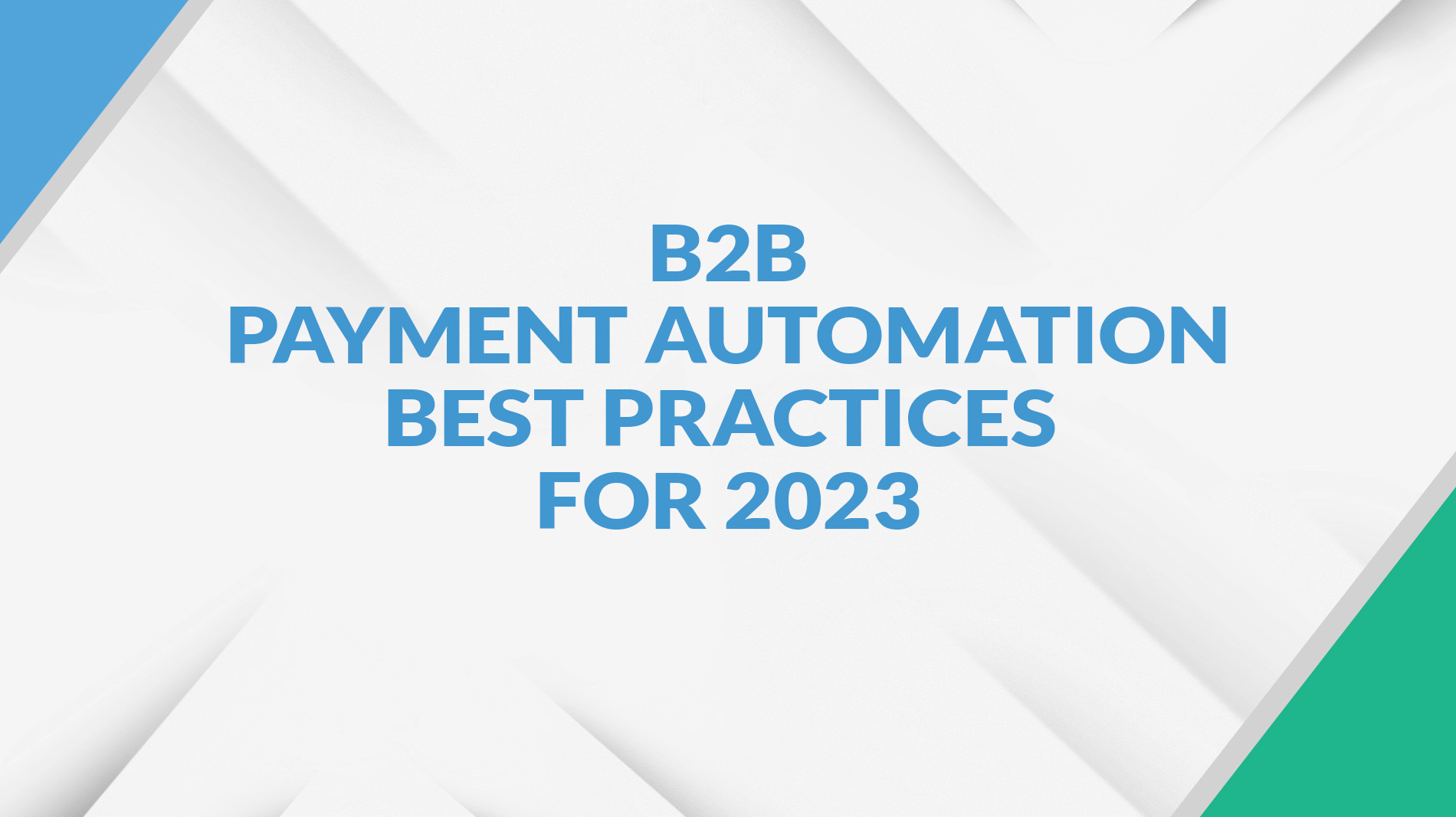Automated Accounts Receivable Programs: Cutting DSO by 30% in Six Months
In today’s economy, speed to cash is as important as speed to market. Companies that let receivables linger for 60, 75, or even 90 days are putting...

If you haven’t already noticed, payments automation has come a long way recently. In fact, with the AP automation industry poised to grow to $6.7 billion by 2032 from $2.3 billion in 2021, the subject of automating payment processing will likely be on many financial executives’ short lists in coming years.
Where is your business in the race toward B2B payment automation?
Maybe payment automation is a new idea, and your AP team is currently manually reconciling check payments via phone call. Or maybe you’re considering different options and want to make sure that you’re approaching your digital transformation the right way. Lastly, you might already have partially or fully automated your B2B vendor payments and are just looking for ways to improve the process further.
Regardless of where you’re starting on the payments automation track, you will learn to navigate it better using this handy guide. So buckle up. It’s time to put your foot on the gas …
But first..
B2B payment automation can be broadly defined as software technology that streamlines the payment process with your vendors. When you employ a payment automation solution, you can offer digital payment options to vendors via credit cards, ACH payments, and virtual card payments. Some solutions will also help you gather valuable cash rebates, index and catalog all transactions for easy recall, and provide real-time, useful financial data.
Even if you’ve got vendors that prefer paper checks, a good payment automation solution can help speed up the process because the software stores your vendor data after it’s entered (the first time) and keeps it in a centralized location with other payment information. Plus, you get the option of cutting individual or batch checks from that payment location.
It probably comes as no surprise that an accounts payable department has some of the most time-consuming and tedious workflows of a business. Manual AP processing typically includes repetitive data entry tasks, paper-based PO and statement matching, manual approvals, and manual posting to a business’s ERP or accounting software.
Automated payment processing helps turn this around by eliminating many cumbersome tasks, especially when paired with an AP automation solution. With the right automation fit, your business will be able to reduce overall AP processing costs, increase efficiency, improve accuracy, and decrease incidents of fraud.
See what happened when Kettle Cuisine chose PAYSmart and APSmart to drive digital transformation in their accounts payable and payments processes. Read the case study here.
Top 6 AP Practices for High-Performing B2B Payments Automation
Some automation software companies will try to sell you on the idea that they offer full procure-to-pay (P2P) capabilities—when really—their solutions are only good at automating a few AP functions. That’s why understanding your business’s pain points and knowing what makes up AP best practices will help you find a B2B payment automation solution ideal for your business.
Here are some top AP practices to aim for:
To begin automating your AP processes, it’s important to use a accounting payable automation solution like APSmart that offers end-to-end invoice automation. The software should be customizable, offer full process visibility, and be able to:
Once your AP solution is customized and implemented, you can use a payments automation solution like PAYSmart by CloudX to centralize all payment information into a single interface. From here, you can execute payments more efficiently and gather monthly cash rebates on all eligible purchases. CloudX calls this concept “integrated payables,” which basically means combining payments of all channels and types into one combined payment flow.
A good audit trail will record all transactions and details of your AP workflows, from POs and non-PO invoices all the way to payment reconciliation. It should be able to detect errors, assure compliance, support your SOPs, and provide full visibility of activities and communications related to each transaction.
While you can still use manual processes to supply an audit trail, it can be risky and time consuming—especially if you’re trying to scale your business upward. On the other hand, AP automation can largely improve your audit trail because it not only centralizes and provides easy recall of data, but it simplifies invoice processing, controls approval authorities, and tracks all payments. It also helps reduce human errors and assists in preventing fraudulent activity both internally and externally.
Did you know that around 40% of all B2B payments are still made by paper check? If that number surprises you, these might surprise you a little more: The average cost of processing a check is $3 to $6, and this range doesn't even consider the additional inputs involved, including postage, materials, and labor. Overall cost gets even higher when you account for incidents of double payments, missed payments, check fraud, and other processing missteps encountered by an AP department.
B2B payment automation can take the cumbersome task of check payments and transform them into fast, real-time payments to your vendors. That said, part of your business’s automation journey can include conversations with vendors about the benefits of choosing different payment methods other than checks. As you explore options, you might find it easier to replace vendors resistant to change with ones that accept electronic payments.
When a vendor won’t accept virtual cards or credit cards, you’ve got a couple options remaining: paper checks or ACH payments. And if you’ve read #3 above, it’s pretty obvious why encouraging ACH payments is the better of the two.
One distinct advantage of ACH payments over check payments is that they have lower processing fees, ranging from $0.20 to $0.50 each on average. You can also expect ACH transactions to settle within three to five business days, while checks can take five to seven days or more.
Using a payment automation software also makes processing ACH transactions even easier since you’ll be able to pay invoices from a single platform, have access to full transaction details, and see real-time payment status updates on the platform.
Getting vendors to accept virtual card payments is a beneficial first step when you choose an automated payment processing solution. This changeover can lower your staff’s payment processing time as well as increase your business’s eligibility for cash rebates.
Sometimes, all it takes is informing a vendor that they’ll receive their money faster by accepting virtual card payments. This not only saves them from having to follow up on invoices, but it provides them the immediate cash they need to operate their business. To further incentivize card acceptance, try setting shorter payment terms and offer to pay vendors by virtual card first, followed by credit cards, ACH transactions, and then checks, respectively. Just make sure your AP department can stick to these payment timelines before negotiating anything.
Whether or not vendors agree to accept virtual card payments, this is an opportune time for you to review all existing payment terms and work to renegotiate your agreements and terms.
As a leader in finance, you most likely shoulder the responsibility of identifying inefficiencies in your AP department and finding cost-effective solutions that both save money and incentivize higher profits.
If you plan to introduce a payments automation solution, you will want to give stakeholders a solid value proposition in order to get them on board with your spend proposal. One of the most straightforward ways to exhibit this is by showing how payment automation software can assist your business in gathering cash rebates using virtual cards to pay vendors.
Besides being one of the most secure forms of electronic payment, virtual cards can gather your business cash rebates of up to 1% per dollar of spend, on average. If you compare credit card rewards to these cash rebates, you’ll discover that cash rebates can actually double your cashback earnings.
Here’s an example:
|
Earnings per Month |
Earnings per Year |
|
|
Credit Card Rewards $0.005 cashback per point earned 1 point=$1 of spend $250,000 spend per month |
$0.005 x $500,000= $2,500 earned per month |
$0.005 x $500,000 x 12 months= $30,000 earned per year |
|
Virtual Card Cash Rebates 1% cashback per dollar of spend $250,000 virtual card spend per month |
$0.01 x $500,000= $5,000 earned per month |
$0.01 x $500,000 x 12 months= $60,000 earned per year |
If you’re looking at payment automation software, getting the most for your money is critical, so make sure that the solution you choose will help your AP department gain efficiency, cut costs, and capture some earnings too.
Here are some B2B payment automation features to watch for:
Flexibility. How many different types of vendor payments do you make? A good solution allows for a variety of payments, and you should be able to administer them from a secure, centralized platform according to your timelines and payment methods.
Integration. Your payment solution needs to work seamlessly with your AP automation software, and both must also integrate with your accounting system so that all transactions, approvals, and payments are able to sync.
Customer Service. Access to training, ongoing customer support, and prompt service are key aspects of a reputable payment automation software. And make sure there aren’t going to be any hidden fees.
Reporting. Look for a solution that’s able to show payment status in real time, give you detailed history, and provide analytics to help measure important KPIs.
When implemented correctly, a B2B payment automation solution can streamline your vendor payments and improve your relationship with vendors–in addition to helping your business thousands of dollars in cash rebates.
PAYSmart by CloudX is a perfect way to simplify your payments while receiving monthly rebates on eligible purchases. When combined with the AP automation solution APSmart, your AP department will have an end-to-end automation solution capable of helping you speed into the digital age of accounting.

In today’s economy, speed to cash is as important as speed to market. Companies that let receivables linger for 60, 75, or even 90 days are putting...

Managing operational costs today often means balancing operational costs against tight margins, making it essential to join a group purchasing...